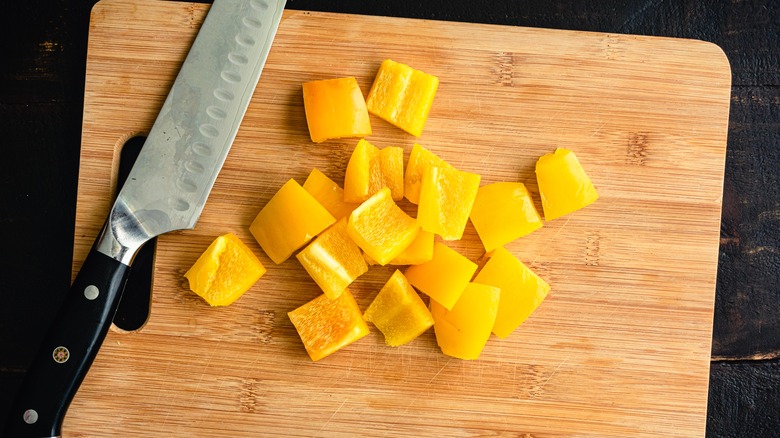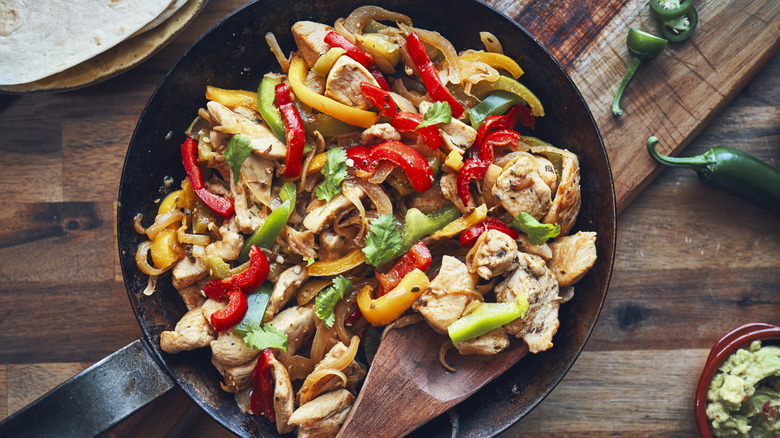Ina Garten's Pro Tip For Slicing And Dicing Peppers
We may receive a commission on purchases made from links.
Ina Garten consistently dispenses practical advice for hosting, from preparing a big batch of Cosmopolitans in advance to what size chicken is the best to roast for a group. Garten's 2018 cookbook, "Cook Like a Pro," shares her well-respected, streamlined recipes and the tips she's picked up over the decades from working with professional chefs, including how to slice and dice bell peppers.
Sweet bell peppers, a member of the nightshade family, are commonly referred to as vegetables although they are technically fruit. Purchase ones with smooth, firm skin: Wrinkles or puckering indicate they're old. Although edible, its seeds are usually discarded since they can be bitter with an unappealing crunch.
There are several methods for cutting peppers; however, Garten's pro tip makes quick work of the task and delivers professional-looking flat pieces ideal for even dicing. In the "Cook Like a Pro" cookbook, Garten suggests, "Holding the pepper upright, cut down the sides, and dice." Her time-saving technique also keeps the seeds attached to the stem, leaving no mess behind.
Ina Garten's pepper hack
To use Garten's hack, begin by placing the bell pepper, stem up, on a cutting board. Using a sharp knife, cut vertically down the right side of the pepper from the stem to the bottom (apex), following the curved shape. Rotate the pepper 90 degrees and repeat the cut thrice until four large pieces are on your cutting board. If a small square piece of pepper is still attached to the bottom, don't waste it — cut it off to snack on or dice, but discard the stem and seed cluster, which should still be connected.
With the skin side down, clean the flesh by removing the white ribs. If preparing the pepper for a crudité, you can further trim it by slicing a thin layer from its surface to remove the dull-looking pith. It's unnecessary if you cook the pepper, but it makes it look more appealing and professional when served raw.
Keeping the skin side on the cutting board, evenly slice the pepper into ¼ to ½-inch strips, which can be used to snack on or for recipes like fajitas or an Italian sausage and pepper hero. To julienne the pepper for a salad, make the slices thinner, at ⅛ inch thick.
To dice or cube the pepper, combine a few slices, skin side down, and cross-cut them uniformly. A small dice is roughly ¼-inch square, a medium is ½-inch, and a large dice is ¾-inch square.
Cooking with bell peppers
No matter what size the chop is, ensure you are cutting the fruit with the smooth side down to prevent the knife from slipping. Even a sharp blade can struggle to pierce the skin, causing an accident. The exception to this rule is when you slice the pepper into rounds or remove just the top to stuff it.
Diced bell peppers are sauteed with other aromatics to create the Cajun holy trinity and a Spanish sofrito. Traditionally, Creole recipes begin with a combination of onions, celery, and peppers, replacing the carrots in a French mirepoix or an Italian soffritto (battuto) for peppers. This flavorful base is the inception point for famous Louisiana dishes like gumbos and jambalaya.
It's best to use cut peppers immediately, but leftovers can be stored in an airtight container in the refrigerator for up to two days. For more extended storage, freeze the cut fruit. Simply wash and dry the skin and cut it into the desired shape; there's no need to cook the pepper first. Freeze the pieces in a single layer on a parchment-lined baking sheet until solid, then transfer the pepper to a resealable freezer bag for up to six months. This is an excellent meal prep time-saver and a good use for a pepper about to go bad. Since a defrosted pepper won't be as crunchy as its fresh counterpart, this preparation is ideal for cooking versus enjoying it raw.



